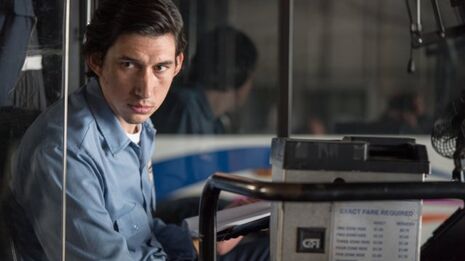Paterson, Whiplash and Bird
Part of the Cambridge Film Festival, Paterson (2016) shows the value in making films about the plight of artists

After leaving a late night screening of Jim Jarmusch’s Paterson as part of last week’s Cambridge Film Festival, I started pondering what the point of it all is. More specifically, what is the point of films about art and the artist? Surely art itself is the true reflection of the artist – the material embodiment of their thoughts and life story. Why devote an hour and 40 minutes considering their plight? Paterson, the story of the fictional poet and bus driver Paterson, offers an answer.
The film starts as it means to go on, poetic tropes gradually realising themselves in the language of the film. Shots of arbitrary details – a knee, the hinges on a bus door, an industrial dam – all serve to capture the poet’s capacity to hone in on the mundane and elevate it to literary significance. Jarmusch, as one would expect, shows great skill in integrating repetitions of dialogue and recurring visual motifs to generate an internal rhythm so that the film starts to hum along like a rigidly metered poem. But this is not the point. Being able to spot homonyms embedded in the dialogue is precisely the kind of niche, pat yourself on the back film observation you’d expect from a first year English student.
But what if these tropes, as well as being mimetic, are allegorical? What if the films’ concerns about the artist’s struggle are merely veiled concerns about our own? Consider Alejandro G. Iñárritu’s Birdman . The use of the (not actual) continuous take blurs the line between the actors on stage in performance and the actors offstage suggesting an ambiguous seamlessness between selves – where do their performances end, off-stage or on? So far, so self-indulgent. But let’s interrogate this further. Consider our own capacity to present different versions of ourselves. How often do you lose sight of one self and notice another self taking a dominant role in your everyday life? ‘I’m shy normally but in that last supervision I shouted everyone down with my opinions on the efficacy of the semi-colon’. Birdman actualises this psycho-social phenomena – the washed up actor, Riggan Thompson, haunted by his id (in the form of his retired superhero persona), suffers both crippling self-doubt and monumental arrogance that gives him ‘flight’. The selves elide into one other seamlessly, disorienting him and pushing him to near psychosis. Sound familiar? Remember Freshers’ Week: “I’m on top of this, I’ve got this university thing down pat – hello Cambridge – oh, actually, my room’s quite cosy and that guy I was talking to last night definitely hates me. I think I’ll stay inside and get Dominos to deliver’.
Whiplash, a film about a narcissistic and determined drummer and his narcissistic and determined teacher, also works as an elegy on the exhausting nature of ambition. The percussive jazz of the soundtrack not only references the character’s vocation, it conjures the adrenalised heartbeat of someone striving for perfection. The tap-tap-tapping of the drum is like the tap-tap-tapping of fingers on a keyboard as you furiously assimilate last week’s reading into essay-form, your heart beat duetting with the syncopated taps of the keys. What starts as specific to the film evolves into something universal. The artist, and film, become a sensory conduit for the heightened emotions of the audience.
So how does the literary Paterson’s appropriation of poetic tropes resonate with an audience striving for a more personal cinematic experience? Like many of Jarmusch’s films, the film is interested in existential ennui and bathes in the mundane and lonely experience of living. His attention to detail and his commitment to scrawling verse in his battered notebook give his life an anchor, a prism to see things through, to combat the mundanity, but so does any hobby. The film merely emulates this. However when, later in the film, the character’s writing suffers a major set-back, the character visibly degenerates – his lips adopting a blue hue, his shoulders rolling in on himself. But a chance encounter with a Japanese poet provides reinvigoration. The pair engage in an elliptical discourse on the lives of poets and suddenly we recognise the form’s impact on the character’s life. It offers an opportunity for discourse, to engage with the world through shared experience.
The poet, the actor and musician all strive for communion with their audience. Though all these films adapt their form to replicate that of the artist’s, their central concern goes beyond the imitative. The films reflect back at the audience the difficulty of communication, of transmitting ourself in the social sphere. The archetype of the artist in film whether through drumming, acting or writing, symbolises our own own thirst for an efficient communication of self.
 News / Newnham postgrads referred to homeless charities as College runs out of rooms31 July 2025
News / Newnham postgrads referred to homeless charities as College runs out of rooms31 July 2025 Arts / William Morris’ little-known labours in Cambridge25 July 2025
Arts / William Morris’ little-known labours in Cambridge25 July 2025 Lifestyle / Break-ups in the bubble31 July 2025
Lifestyle / Break-ups in the bubble31 July 2025 News / Lucy Cav secures £47m loan to expand student accommodation30 July 2025
News / Lucy Cav secures £47m loan to expand student accommodation30 July 2025 Theatre / One year, many stages: the fresher actors behind Cambridge theatre31 July 2025
Theatre / One year, many stages: the fresher actors behind Cambridge theatre31 July 2025








